Pareidolia
Epiphany versus Apophany
May, 2024

Apophenia is a common vulnerability of human brain function. It is the misattribution of meaningful patterns within unrelated data. Taken to extremes, it forms the basis of schizophrenia, where a person is increasingly detached from reality. We risk being wrong whenever we assign meaning to a newly detected pattern. But risk is required for discovery, innovation, and the general exploration of reality.
Seeing faces in an otherwise random pattern is normal and healthy. The experience is called Pareidolia and it's a type of Apophany, an instance of apophenia. Apophany should sound somewhat familiar because it is the polar opposite of Epiphany. These are the Yin & Yang of discovering meaning in otherwise meaningless, chaotic stimuli.

The ability to detect patterns within a chaotic background is essential to survival. Predators utilize camouflage to escape visual detection. The leftmost image in the Banner above is a popular "Can you spot the Snow Leopard?" meme. There is an actual Snow Leopard, blending nicely into its hunting environment. The "Lion in the Fence" to the right is a case of pareidolia and I made sure I was able to find multiple examples from various photographers. Photo manipulation software has made a sport of creating "hidden faces," which are not pareidolia, as the pattern doesn't originate from genuine chaotic stimuli. To the right of these image slices, the face in the clouds is a strong example of pareidolia! The longer I look, the more subtle and realistic is the face I perceive (scroll upward if necessary).
Fusiform Face Area
"The baby, assailed by eyes, ears, nose, skin, and entrails at once,
feels it all as one great blooming, buzzing confusion."
—William James, Principles of Psychology (1890)
We have learned a bit more about cognitive development since James's observations in the 19th century, but he was correct that a baby's perceptual skills are underdeveloped and need time to mature. When an infant is born its visual acuity is estimated at 20/400. Depth perception takes several months. There is a long list of what a newborn can't do, but what they can do is recognize faces!
A Britannica article on infant perception says, "Newborns’ ability to recognize facelike patterns suggests that they may have an inherent ability to perceive faces before having actually viewed a face." Advanced imaging (PET and fMRI) in the 1990s discovered an area of the brain apparently specialized for detecting faces. This was named the "Fusiform Face Area" and has an identified location in the brain. In cases of pareidolia, this area is triggered even before cognitive reinterpretation takes place. In other words, face detection is hard-wired into human perception.
Optical Illusions
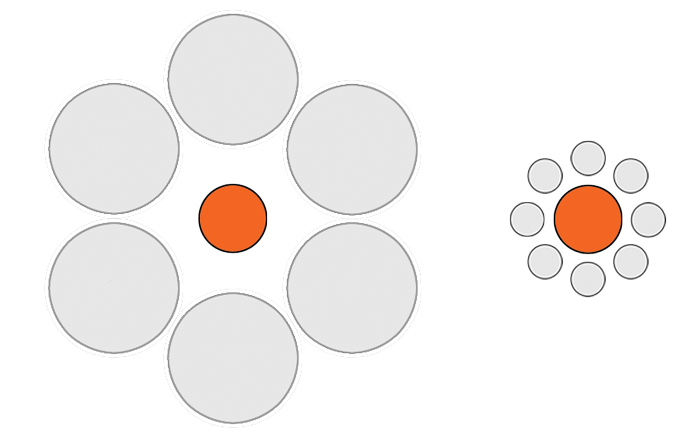
The orange circles are the exact same diameter but the one on the right appears larger.
Optical Illusions trick our eyes, misleading us about reality. But they don't invite the same misattribution of meaning as a genuine Apophany does.
Clouded Judgement
Pareidolia can be judged as a "Type 1 Error" — an error of "Commission" or a "False Positive." But when a normal person sees a beautiful face in the clouds they probably don't assign it greater meaning, unless they have been "praying for a sign." Under those circumstances, some may conclude that "an angel appeared." The visual stimulus, coupled with a pre-existing belief, is what completes the Apophany.

This type of error is not confined to the traditionally religious. When images were sent to Earth from the Viking 1 Mars explorer, the "Face on Mars" (above) was detected. People fascinated with "Lost Civilizations" saw the same face as everyone else. But they also saw a megalithic ruin on Mars, reminiscent of the Sphinx, and proof of visits to Ancient Egypt from an extraterrestrial intelligence. (Later images, under different lighting, diffused this Apophany.)
Taking a Chance
Apophenia is not limited to the facial illusions of Pareidolia. Patterns can be detected in other experiential modes. The "Gambler's Fallacy" is a popular example of an error in pattern detection.

• Gambler That sequence is DUE for Tails! The chances of getting seven Heads in a row is like 1 in 128. All my money is on Tails!
• Academic Coin flips are independent events. Sure, the chances of 7 Heads in a row are very low, but given the first 6 already happened it no longer matters. The next flip is still only 50/50.
• Skeptic I see a pattern of 6 Heads in a row. Why would I expect something different now? This could be a two-sided coin or just a process of placing coins "heads up." If this is an anomaly of a fair coin toss, then it's 50/50, so Heads is as good a guess as Tails. But maybe it's not a fair coin toss. So I strongly predict another Heads.
Kensho Shouts Eureka!
Let's flip the switch off apophenia and explore Epiphany. The Greeks defined the word in terms of "insight through the divine." That's a much grander scale than current psychological experiments on the "Aha! Moment." But perhaps the experience of solving puzzles in a lab can be useful to get us started. Four attributes seem to characterize the "Eureka Moment" in solving difficult challenges with otherwise known solutions:
- The problem is resolved with a clear and elegant solution.
- The solution is experienced as a sudden breakthrough.
- The solution provides a state of satisfaction or joy.
- The solution is immediately judged as "True."
The Nine Dots Challenge is a psychology lab experiment, hoping to elicit an "Aha! Moment." When presented with the grid of nine dots, the subject is asked to "draw 4 straight lines that connect all of the dots without lifting the pen between lines." The number of subjects that solve this puzzle after 3 minutes is 0%.

My image has some examples of how you might approach this and also presents the "out of the box" approach needed to solve it. My presentation will not create an Epiphany or even a proper "Aha! Moment," since I cheated you out of the struggle necessary to discover the solution. You probably won't even gain "universal insight" into "out of the box" solutions.
But let's see if we can remember a shared experience that may have felt like an Epiphany
Once Learned, You Never Forget...

Einstein is one of the three most used examples regarding Epiphany and scientific discovery. Archimedes (of "Eureka!" fame) and Isaac Newton with his Apple are the other two. So it was pretty satisfying to be able to quote Einstein when remembering how to ride a bike for the first time.
Strider balance bikes make the transition to riding a regular bike safer and more seamless. I suspect the diminished struggle precludes an Aha! Moment though. For previous generations the experience was more like this: You would sit on the seat and grip the handlebars of a bike too tall for you to touch the ground. An adult would be holding the bike upright so you didn't fall over. After some detailed instructions like "Pedal — Pedal — Pedal!" the adult ran along behind, manually supplying your balance. And then they would let...go...
Crashing at speed seems worse, so initial attempts usually involved NOT pedaling, slowing, squealing, and falling over. If progress is made before the patience of your handler extinguishes, you discover the moment of balance at speed. It's magic!
Catching a wave, or riding an extended wheelie are similar, but there are precious few moments like this. Physical epiphanies do differ from intellectual breakthroughs, and the immediate feedback prevents physical apophanies. Or at least sober ones.
Peering into the Empyrean
For Medieval Christianity, the Empyrean was the third heaven and beyond "the heaven of the air and the heaven of the stars." The woodcut above was published in 1888 but most likely represents an earlier work. A monk has broken through the known Universe and is peering into the Empyrean. This is a great visual representation of someone having an Epiphany.
Epiphany = Cacophany - Apophany
Epiphany is an ancient Greek word, but Apophany wasn't coined until 1958 by psychiatrist Claus Conrad. I do find Apophany an increasingly useful term. The key portion of both words is "–phany" which I will summarize as "Illumination." The prefix "Epi-" means "upon" or "toward." The prefix "Apo-" is the opposite and means "award from." Both are used in terms of a subjective feeling. So an Epiphany is a mental experience that brings you toward illumination. When it happens, an Apophany may feel the same, but it actually takes you away from illumination — the true state of reality.
"Cacophany" is a term I am coining now, as a needed compliment to the other two words. It sounds like "cacophony," which refers to chaotic, disorderly, and discordant sounds. The "-phony" root refers to sound, and the prefix "Caco-" refers to "bad." So you have an unpleasant auditory experience when you experience Cacophony. By combining the "Caco-" with our root for illumination, I came up with "Cacaphany," which is the state of "bad Illumination" prior to realization. It represents the chaotic, disorderly state of information.
My title formula "Epiphany = Cacophany - Apophany suggests that to reach an Epiphany you must start with the chaotic state of Cacophany, and reject false solutions presented through Apophany.
Epiphany Precursors
When we recount epiphanies related to scientific breakthroughs, we are actually not talking about actually solving deep problems, but rather the flash of insight that suggests the solution path. Isaac Newton's falling apple triggered his realization of the universal force of gravity. Einstein's thought about a man free-falling in an elevator triggered his equivalence between acceleration and Newton's gravity. In both cases, there was still a lot of math to be worked out, but the sudden perception of a fundamental truth had occurred.
My Personal Epiphany
And now we come to the conclusion and discover what set these wheels in motion.
To fully experience the impact of this Epiphany, you need to start with the state of mind I rightfully had at the end of my article "The Numbers." It's worth taking a break and going back to read it if you have not. As a review, the salient points are:
- Prime Numbers are supposedly chaotic but seem to have a generating pattern.
- Discovering the definitive pattern is math's "Holy Grail."
- The unpredictability of Prime Numbers makes them the basis for digital security.
- Solving Prime Number generation represents dangerous and forbidden knowledge.
In the article I go over experiments I did with various "Prime Wheels," their triumphs, and limitations.
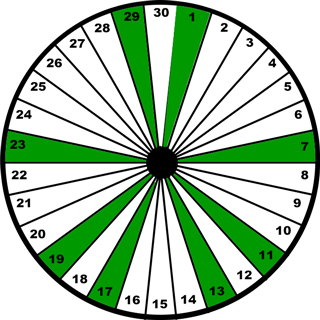
I think I made some advancements compared to anything I could find online and can generate (or detect) reasonably large prime numbers. The upside of the Prime Wheel is that it does generate every single prime number. The downside is some non-prime composites also get through and have to be eliminated with "trial division." Trail division is not a scalable technique and after several months of effort, the experiment ends there. I conclude the definitive pattern would require an unknown symbol manipulation technique or the development of a Prime Clock.
A month or so after finishing the article, I was in bed, thinking about what it would take to create a "Prime Clock." I was struck by a vision of counter-rotating, intersecting rings within rings. Something I thought I had seen in a movie perhaps, but long ago. It turned out the image I was thinking of was from a movie a friend did miniatures for in 1997. I later found out the name of the device is the Hokkaido Machine, from the movie Contact.
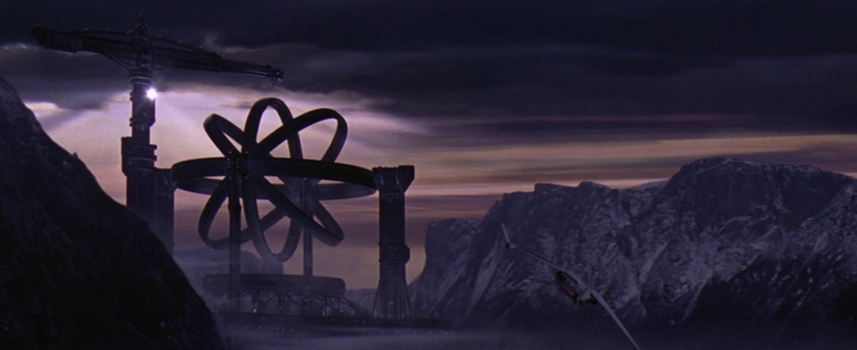
My curiosity satisfied, I set out to start making notes of all the non-primes that were being produced by the 30-Slice wheel above. Armed with stacks of paper with repeating wheel images, I started making notes in pencil and looking for a pattern. Remembering almost nothing about the movie, I also planned to rewatch Contact to see the machine in action, and possibly get a hint about my vision.
After sifting through the patterns of non-prime numbers for many days, I had the Eureka! Moment. It was a stronger revelation than finding a solution to an impossibly hard problem. It was finding a solution that was not supposed to exist!
The classic psychological markers for an Epiphany were there:
- Preceded by a long mental effort.
- Clear and elegant solution.
- A sudden breakthrough.
- Immediately judged as "True."
- State of satisfaction or joy.
My state of joy was temporary, however, quickly being replaced with a low-grade feeling of danger.
I will write more about that experience and what I discovered in a future article titled "Doomsday Mechanism." In the meantime, I will say the discovery was entirely bottom-up, derived from the numbers themselves. I was attempting to decode a math puzzle using some problem-solving techniques I developed over 30 years. None of this is, or was, an attempt to justify some metaphysical beliefs. The "Occult Tapestry" I am weaving started with "The Numbers" and got stranger on its own in "Comprisation." A lot of my recent writing and research is an attempt to figure out "just what did I really just uncover?"

It Continues to Get Weirder
The 3D intersecting rings of the device from Contact were a nice inspiration, but I couldn't connect it to my Prime Clock challenge. Ultimately my solution followed the flatter design of clocks with gears interacting with other gears. Perhaps I was influenced by the Antikythera Mechanism I teased at the conclusion of The Numbers.
In re-watching Contact, I was struck by how well it was done. The main character, Ellie, is a SETI researcher, tirelessly monitoring background noise coming from space. There is a scene of her on the hood of a car, listening with headphones, alone, resolved to detect some sign of intelligent communication. It resonated with my own visual search through a sea of numbers, looking for some kind of repeating pattern.
The movie is named Contact so it's not a spoiler to reveal Ellie's determination pays off: A definitive signal comes through and reveals its source as intelligence seeking other intelligence. The scientists conclude this BECAUSE IT'S BROADCASTING PRIME NUMBERS!
That connection to the Prime Clock was more than enough to shock me. My vision of the type of design that could solve prime numbers, and a hard science fiction story (written by Carl Sagan, no less) that has "A Message" from the heavens, communicating that particular design, and prefixed by Prime Numbers. Too wild. In the movie, a sphere is timed to drop through the whirring rings of the Hokkaido Machine. Except I missed a detail. Through fact-checking, I just learned it was not a sphere, but rather a Dodecahedron! (That particular Platonic Solid features as "the Black Sheep" in my Comprisation and also my article The Elements).

One More Thing
I looked up "Epiphany" on Wikipedia, where I came across the image we saw earlier:
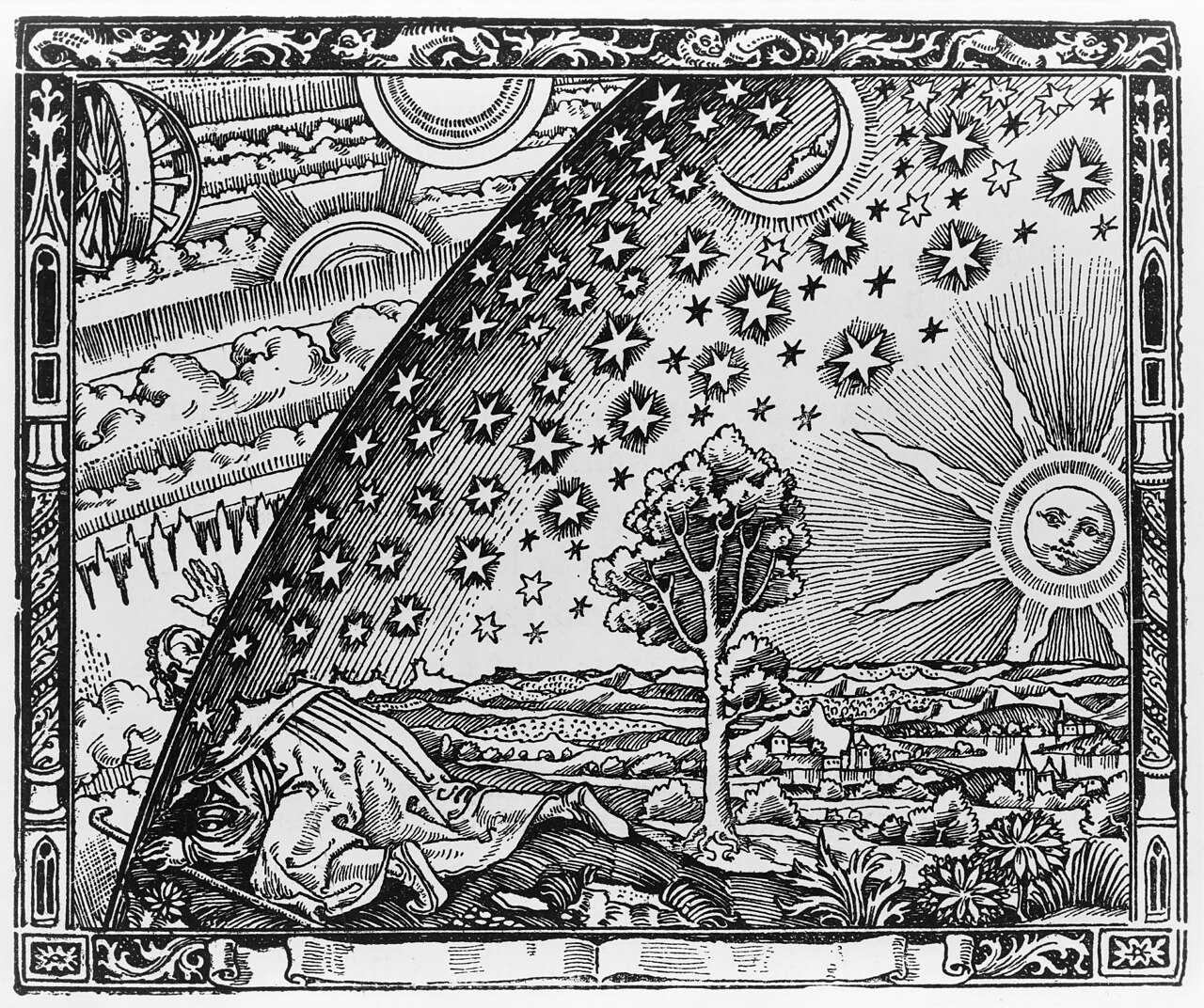
There is a cool little face within the eight rayed Sun, overlooking a little town. This is the earthly realm on which the monk's body is grounded. The Empyrean the monk is peering into is clearly a higher realm. But what is this? — the object partially hidden in the upper left corner?
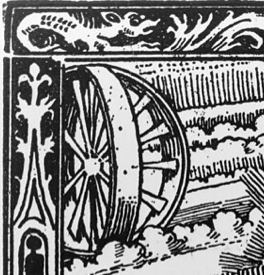
I'm not predisposed to recognizing biblical iconography, but looked up "Wheel within a Wheel" and ended up on a Wikipedia page for "Merkebah mysticism." (Part of that canon cautions about "secret doctrines not to be discussed in public.")
Ezekiel's Vision

The 17th-century illustration directly above is of "Ezekiel's Vision," depicting an account from the Dead Sea Scrolls. There is a lot more to that topic, but from what I could gather the wheel portion of the image represents a type of angel (the ophanim). This illustration predates the Empyrean woodcut by over 100 years. But the "wheel within a wheel" depictions are beyond coincidental and I have to believe they are intended to represent the same thing. What is different is the circumstance. The Empyreal is a realm beyond the sphere containing the stars, and the wheel is discovered. Ezekiel's vision happens within our earthly atmosphere, accompanied by instructions from God.
What I was surprised by (OK, yet another thing) was the Wikipedia "See Also" section under Merkebah mysticism that lists "Contact (film)." What?
That connection is not further explained, not in the article, not in the movie, but if I blow up a section of the Ezekiel illustration I find this:
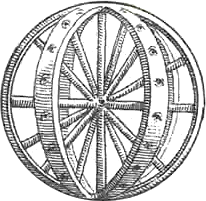
Other depictions of "a wheel within a wheel" are literally two inter-rotating rings. But if you look closely, this particular illustration reveals THREE inter-rotating rings, the same as my vision, the same as the Hokkaido Machine from Contact. Which was a design transmitted to Earth by a superior intelligence from beyond the stars. And encoded within the stream of Prime Numbers.
Is this a case of Apophenia? Are there meaningful links to reality here, are Prime Numbers related to a three-axis gimbal, or is this just another Face on Mars?
Wonderful Wizard of Cosmos
PART TWO starts the investigation of Carl Sagan's Contact; was it coincidence or intentionally Occult?